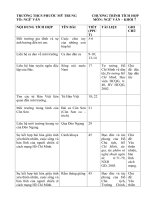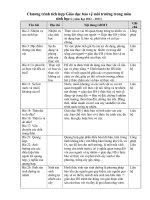chương trình tích hợp khối 7 phần 3 090315032020 thcs minh đức
Bạn đang xem bản rút gọn của tài liệu. Xem và tải ngay bản đầy đủ của tài liệu tại đây (195.96 KB, 4 trang )
<span class='text_page_counter'>(1)</span><div class='page_container' data-page=1>
<b>Static Electricity</b>
Read<b>pages 126-127</b>(5.1 Static Electricity) in your Longman Physics book
Complete<i>questions 1-3</i>on<b>page 129</b>
<b>Static Charge Lab</b>
Type the following address for the<i>PHET Interactive Simulator</i>into your web browser:
/>
Make sure that the “show all charges” button is selected. You should see a sweater with positively
charged particles (Protons)and negatively charged particles (Electrons) as well as a yellow balloon with less
particles.
1. Using the PHET Simulator, take the balloon and place it near the wall. Describe what happens below:
<i><b>The balloon stays to where it is placed.</b></i>
2. Take the yellow balloon and drag it across the sweater. You will observe that the<b>free electrons</b>on the
sweater attach to the balloon, which previously had an even amount of positive and negative charge.
Release the balloon and describe below the effect of this transfer of electrons:
<i><b>Once the balloon has taken all of the free electrons from the sweater it becomes statically charged and</b></i>
<i><b>attracts to the sweater.</b></i>
3. Using page 126-127, define the following words:
a. Static Electricity:<i><b>Electricity which does not move easily.</b></i>
</div>
<span class='text_page_counter'>(2)</span><div class='page_container' data-page=2>
<b>Electricity Circuits</b>
1. Using Figure 2.2 on page 130, draw the simple circuit below.
2. The image in your book has an open switch. Describe the effect of the open switch. What would change if
the switch were to be closed?
<i><b>When a switch is open, electricity is unable to move along the circuit and the bulb cannot light up. If</b></i>
<i><b>the switch is closed then the electricity will flow and the bulb will light up.</b></i>
3. Using pages 130-131, define the following words:
a) Circuit:<i><b>An arrangement of electrical components.</b></i>
b) Conventional Current:<i><b>The way that current flow is described in textbooks, from positive to negative.</b></i>
c) Electron Flow:<i><b>The movement of electrons through a wire from the negative terminal to the positive</b></i>
<i><b>terminal of a cell.</b></i>
d) Short circuit:<i><b>An easy route for the current to flow.</b></i>
4. Identify (draw) the circuitry symbols for the following terms:
5.
</div>
<span class='text_page_counter'>(3)</span><div class='page_container' data-page=3>
6. Using Figure 2.4 and 2.5 on page 131 of your book, draw and label a series and parallel circuit below.
7. Describe the difference between opening and closing a switch on a series circuit to opening and closing a
switch on a parallel circuit.
<i><b>When you open a switch at any point in a series circuit all of the bulbs will go out. When you open the switch</b></i>
<i><b>along one of the paths of a parallel circuit only the bulbs in the line of that path will go out. This is because</b></i>
<i><b>the current flow in the Series circuit cannot be completed if there is one disruption, however the parallel</b></i>
<i><b>circuit can still complete a current flow along an alternate path if one is disrupted.</b></i>
8. Using page 131, define the following words:
a) Series Circuit:<i><b>Components arranged in one continuous loop.</b></i>
b) Parallel Circuit:<i><b>Arrangements of components with separate branches in a circuit.</b></i>
<b>c)</b> Resistance:<i><b>How difficult it is for current to flow through an electrical component.</b></i>
</div>
<span class='text_page_counter'>(4)</span><div class='page_container' data-page=4>
(The following lesson will involve computer and internet access.)
<b>Voltage and Amperage Lab</b>
Type the following address for the PHET Interactive Simulator into your web browser:
/>
This is an online simulator which allows you to create circuits using a variety of materials. In class we use wire,
batteries, and bulbs however there are many different mediums on earth with varying (different) levels of
conductivity (ability to allow heat or electricity to travel through).
9. Using the PHET Simulator, create parallel and series circuits using the different materials.
10. Use the voltmeter and ammeter tools to measure voltage and amperage.
11. Add resistance and voltage and measure the effects.
12. Click the button to switch to circuitry symbol and draw the image shown in the space below:
13. Add at least one unconventional (irregular) type of resistance and describe the effect below.
<i><b>When you add the dollar the bulb gets dimmer. When you add the dog (to a normal battery) there is too much</b></i>
<i><b>resistance for the current to flow.</b></i>
14. Using page 132 and 136, define the following words:
a) Ammeter:<i><b>An instrument for measuring electric current.</b></i>
</div>
<!--links-->









